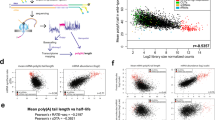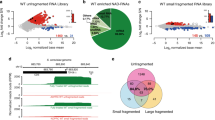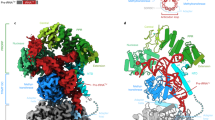Abstract
POLYADENYLIC acid (poly(A)) is present at the 3′ terminus of most classes of cytoplasmic messenger RNAs (mRNAs) in all eukaryotic organisms reported so far1,2. Although the role of poly(A) in mRNA function and metabolism is still a subject for speculation1, its presence has provided a convenient means for isolation of this class of mRNA by its ability to bind to cellulose and nitrocellulose filters, and to hybridise with matrices containing either oligo(dT)3 or poly(U)4. Most poly(A) in cytoplasmic mRNA has been found to be 100–150 nucleotides long, with an electrophoretic mobility of about 7S (ref. 1). The poly(A) segment length of yeast cytoplasmic mRNA is only 50–60 nucleotides, with an electrophoretic mobility of about 4S5. mRNA species with still shorter poly(A) segments of only 19–34 residues have been described in the silk moth6.
This is a preview of subscription content, access via your institution
Access options
Subscribe to this journal
Receive 51 print issues and online access
$199.00 per year
only $3.90 per issue
Buy this article
- Purchase on Springer Link
- Instant access to full article PDF
Prices may be subject to local taxes which are calculated during checkout
Similar content being viewed by others
References
Brawerman, G., A. Rev. Biochem., 43, 621–642 (1974).
Darnell, J. E., Jelinek, W. R., and Molloy, G. R., Science, 181, 1215–1221 (1973).
Adesnik, M., Salditt, M., Thomas, W., and Darnell, J. E., J. molec. Biol., 71, 21–30 (1972).
Nakazato, H., and Edmonds, M., J. biol. Chem., 247, 3365–3367 (1972).
McLaughlin, C. S., Warner, J. R., Edmonds, M., Nakazato, H., and Vaughan, M. H., J. biol. Chem., 248, 1466–1471 (1973).
Vournakis, J. N., Gelinas, R. E., and Kafatos, F. C., Cell, 3, 265–273 (1974).
Hirsch, M., Spradling, A., and Penman, S., Cell, 1, 31–35 (1974).
Groot, G. S. P., Flavell, R. A., Van Ommen, G. J. B., and Grivell, L. A., Nature, 252, 167–169 (1974)
Nakazato, H., Venkatesan, S., and Edmonds, M., Nature, 256, 144–146 (1975).
Ohta, N., Sanders, M., and Newton, A., Proc. natn. Acad. Sci. U.S.A., 72, 2343–2346 (1975).
Casey, J., Cohen, M., Rabinowitz, M., Fukuhara, H., and Getz, G., J. molec. Biol., 63, 431–440 (1972).
Grivell, L. A., Reijnders, L., and Borst, P., Biochim. biophys. Acta, 247, 91–103 (1971).
Hirsch, M., and Penman, S., J. molec. Biol., 80, 379–391 (1973).
Padmanaban, G., Hendler, F., Patzer, J., Ryan, R., and Rabinowitz, M., Proc. natn. Acad. Sci. U.S.A. (in the press).
Jacobson, A., Firtel, R. A., and Lodish, H. F., J. molec. Biol., 82, 213–230 (1974).
Schatz, G., and Mason, T. L., A. Rev. Biochem., 43, 51–57 (1974).
Firtel, R. A., Jacobson, A., and Lodish, H. F., Nature new Biol., 239, 225–228 (1972).
Lindberg, C., and Persson, T., Eur. J. Biochem., 31, 246–254 (1972).
Loening, V. E., Biochem. J., 102, 251–257 (1967).
Author information
Authors and Affiliations
Rights and permissions
About this article
Cite this article
HENDLER, F., PADMANABAN, G., PATZER, J. et al. Yeast mitochondrial RNA contains a short polyadenylic acid segment. Nature 258, 357–359 (1975). https://doi.org/10.1038/258357a0
Received:
Accepted:
Issue Date:
DOI: https://doi.org/10.1038/258357a0
This article is cited by
-
Mitochondrial RNA metabolism during mitochondriogenesis in yeast
Journal of Biosciences (1986)
-
Regulation of flavonoid gene expression in Petunia hybrida: Description and partial characterization of a conditional mutant in chalcone synthase gene expression
Molecular and General Genetics MGG (1983)
-
Comparative studies on biochemical properties of protein synthesis of an archaebacteria,Thermoplasma sp.
Origins of Life (1982)
-
Transcription in yeast mitochondria: Isolation and physical mapping of messenger RNAs for subunits of cytochrome c oxidase and ATPase
Molecular and General Genetics MGG (1978)
Comments
By submitting a comment you agree to abide by our Terms and Community Guidelines. If you find something abusive or that does not comply with our terms or guidelines please flag it as inappropriate.



